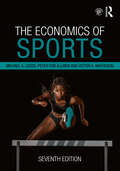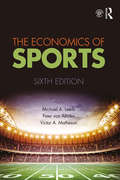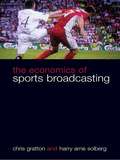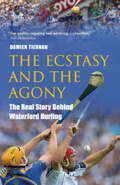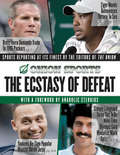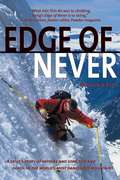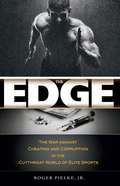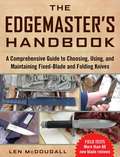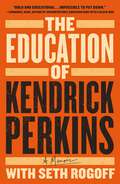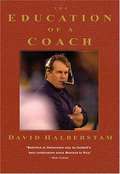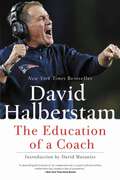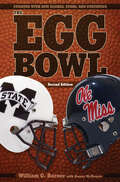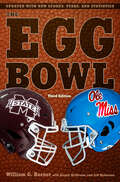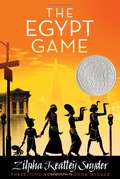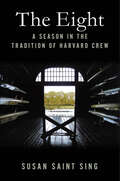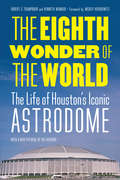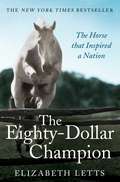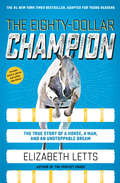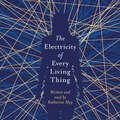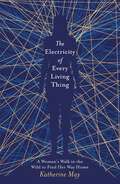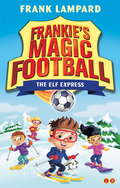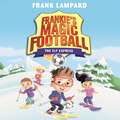- Table View
- List View
The Economics of Sports
by Victor A. Matheson Michael A. Leeds Peter von AllmenThe sports industry provides a seemingly endless set of examples from every area of microeconomics, giving students the opportunity to study economics in a context that holds their interest. Thoroughly updated to reflect the current landscape, The Economics of Sports introduces core economic concepts and theories and applies them to US and international sports. Divided into five parts, the book focuses on three major areas of the economics of sports: industrial organization, public economics, and labor economics. Updates for this seventh edition include: • An entirely new chapter on sports gambling and a fully revised section on intercollegiate sports; • Updated material on social justice in sports and the impact of the COVID-19 pandemic on the industry; • More coverage of international sports, e-sports, and new biographical sketches. This well-presented and accessible text is supported by easy-to-follow pedagogical features, such as end-of-chapter summaries and questions, and a companion website, which offers useful resources for students and instructors. It is the perfect textbook for intermediate and advanced undergraduate and graduate courses in sports economics.
The Economics of Sports
by Michael Leeds Peter Von Allmen Victor A. MathesonFor undergraduate courses in sports economics, this book introduces core economic concepts developed through examples from the sports industry. The sports industry provides a seemingly endless set of examples from every area of microeconomics, giving students the opportunity to study economics in a context that holds their interest. The Economics of Sports explores economic concepts and theory of industrial organization, public finance, and labor economics in the context of applications and examples from American and international sports.
The Economics of Sports (The\addison-wesley Series In Economics)
by Peter Von Allmen Victor A. Matheson Michael A. LeedsThe sports industry provides a seemingly endless set of examples from every area of microeconomics, giving students the opportunity to study economics in a context that holds their interest. Thoroughly updated to reflect the current sports landscape, The Economics of Sports introduces core economic concepts and theories and applies them to American and international sports. Updates for this sixth edition include: More coverage of international sports, including European football; A revised chapter on competitive balance, reflecting new techniques; A brand-new chapter on mega-events such as the Olympics and World Cup; New material on umpire bias; A completely redesigned chapter on amateur competition that focuses exclusively on intercollegiate sports. This chapter is also now modular, enabling instructors who wish to intersperse it with the other chapters to do so with greater ease. This accessible text is supported by a companion website which includes resources for students and instructors. It is the perfect text for advanced undergraduate and graduate courses on sports economics.
The Economics of Sports Broadcasting
by Chris Gratton Harry Arne SolbergSports now constitute one of the most valuable forms of broadcast entertainment in today’s lucrative international market. This textbook explains the economics underlying the sports broadcasting phenomenon. The specific regulatory culture governing sports broadcasting means that the financial economy of this area has many unique features. The Economics of Sports Broadcasting provides an accessible, detailed introduction to all aspects of economics in this fascinating area. The book contains a wealth of textbook features and has been written and designed to facilitate student learning. It includes: questions of ownership, trade and commodity in sport the historical context for contemporary sports broadcasting the key players – viewers, TV channels, sponsors, clubs, event owners and authorities the regulations governing televised sport the international context for broadcast sport competition and game theory in sports broadcasting sports broadcasting’s changing landscape of ownership and supply channels. This book will be useful for courses in media and broadcasting, economics, sport management and sports development.
The Ecstasy and the Agony
by Damien TiernanIn 1998, a determined Waterford hurling team made their way to their first All-Ireland semi-final in almost forty years, their sights firmly set on the final, which would be their first since 1963.But destiny conspired against them and they lost. Over the next twelve years they would, time and time again, play spell-binding hurling, reach the Semi-Finals seven times, Player of the Year Awards and multiple All-Star honours and come agonisingly close to winning one of the biggest prizes in Irish sport. In The Ecstasy and the Agony, Damien Tiernan goes behind the scenes and takes an unflinchingly honest look at how such a great team can come so close to major triumphs but still walked away without the top honours. In over sixty interviews with key players, backroom staff, selectors and managers including Justin McCarthy, Paul Flynn, Davy Fitzgerald, Dan Shanahan, Eoin Kelly, Stephen Molumphy, Ken McGrath, Gerald McCarthy, and many others - Tiernan examines the controversies that have dogged Waterford hurling in recent years. Who are the leaders? What are the key moments around which victory and defeat revolve? And what, ultimately, are the lessons learned? The Ecstasy and the Agony is the full and honest account of a team who will never stop believing.
The Ecstasy and the Agony
by Damien TiernanIn 1998, a determined Waterford hurling team made their way to their first All-Ireland semi-final in almost forty years, their sights firmly set on the final, which would be their first since 1963.But destiny conspired against them and they lost. Over the next twelve years they would, time and time again, play spell-binding hurling, reach the Semi-Finals seven times, Player of the Year Awards and multiple All-Star honours and come agonisingly close to winning one of the biggest prizes in Irish sport. In The Ecstasy and the Agony, Damien Tiernan goes behind the scenes and takes an unflinchingly honest look at how such a great team can come so close to major triumphs but still walked away without the top honours. In over sixty interviews with key players, backroom staff, selectors and managers including Justin McCarthy, Paul Flynn, Davy Fitzgerald, Dan Shanahan, Eoin Kelly, Stephen Molumphy, Ken McGrath, Gerald McCarthy, and many others - Tiernan examines the controversies that have dogged Waterford hurling in recent years. Who are the leaders? What are the key moments around which victory and defeat revolve? And what, ultimately, are the lessons learned? The Ecstasy and the Agony is the full and honest account of a team who will never stop believing.
The Ecstasy of Defeat: Sports Reporting at Its Finest by the Editors of the Onion
by Editors of The OnionThe Sports Page As You've Never Seen It Before From painfully obvious steroid revelations to sex scandals and superstars who announce trades in over-the-top TV specials, the wide world of sports can often seem too ridiculous for words. In The Ecstasy of Defeat, the editors of The Onion offer the laugh-out-loud funny and long overdue lampoon of sports culture you've been waiting for. Filled with the very best of The Onion's bench-clearing sports coverage, this book includes such classics as: Lip-Reading BCS; Computer Kills Officials Who Want To Shut It Down; Barry Bonds Took Steroids, Reports Everyone Who Has Ever Watched Baseball; Report: Cheap Chinese NBA Players Falling Apart After A Few Seasons; Barbaro's Doctors: "A Horse This Good You Don't Eat All At Once."; Lance Armstrong Wants To Tell Nation Something But Nation Has To Promise Not To Get Mad. No topic escapes the satirical slap of America's Finest News Source, and the book covers not only mainstream sports--such as baseball, basketball, and football--but also lesser sports, sports culture, and special events like the World Cup and the Olympics. Featuring all the players, teams, and sports we love--and love to hate--The Ecstasy of Defeat is a must-read for sports nuts and Onion fans alike.
The Edge of Never: A Skier's Story of Life, Death, and Dreams in the World's Most Dangerous Mountains
by William A. KerigIn the world of big-mountain skiing, Trevor Petersen was a legend. Appearing in countless films, magazines and photo shoots, his ponytail flying behind him, he was the very embodiment of the freewheeling spirit of extreme skiing in the 1980s and early '90s. Then it all came to an end. On February 26, 1996, while skiing in Chamonix, France - the so-called Death Sport Capital of the World - an avalanche swept Trevor away. His body was found sitting up in the snow as if gazing at the mountains he loved. Nearly a decade later, Trevor's fifteen-year-old son, Kye Petersen, a rising star in his own right, traveled to Chamonix to ski the run that took his father's life and, with the aid of some of the world's greatest ski mountaineers, to become a member of skiing's big-mountain tribe. There to chronicle Kye's story was William A. Kerig, a filmmaker with a dream of his own - to create a film about the soul of big-mountain skiing and the band of mountaineers who ski the steepest, wildest, most dangerous terrain in the world. In The Edge of Never, Kerig gives us not only a ripping adventure tale about a young man coming of age but a frank and subtle portrait of the extreme skiers who "live big" in the face of death and risk everything to experience the fullness of life in the mountains.
The Edge: Ben and Joe Weider's Guide to Ultimate Strength, Speed, and Stamina
by Joe Weider Ben Weider Daniel GasteluBen and Joe Weider are the legendary founders of the modern fitness movement. Their name is synonymous with athletic excellence and their proven programs have created champion bodybuilders and sports professionals for more than fifty years, making Weider Nutrition International the number-one sports nutrition company in the world. Now in "The Edge," the Weiders share the training secrets of the pros that can help anyone interested in fitness achieve peak performance. <P> Here's why athletes and weekend warriors alike need "The Edge" <P> * Cutting-edge research-The most advanced scientific research on supplements and nutrition informs the book, offering readers a definitive guide to natural performance-enhancing supplements as an alternative to steroids.<P> * Specificity-Fitness goals, weight training, and nutrition programs tailored to individual needs.<P> * The Weider Triangle Method-This simple program combines weight training, nutrition, and skill training.<P> * Variable Weight Training-As the founders of the International Federation of Bodybuilders, nobody knows more than the Weiders about weight training. All of the recommended exercises are demonstrated in photographs by natural bodybuilding champions Mike O'Hearn and Gea Johnson.<P> * Dynanutrition-A revolutionary nutrition program based on the Weiders' 10 Commandments of Nutrition. <P> "The Edge" is an effective prescription for anyone who wants to be on top of their game-and look their best while they're playing it.
The Edge: The War against Cheating and Corruption in the Cutthroat World of Elite Sports
by Simon Kuper Roger PielkeRoger Pielke reveals how sports stars break the rules in their search for a competitive edge.Both entertaining and thought-provoking, THE EDGE not only visits the battlefields in the war against cheating and corruption, but also explores ways to ensure that "the spirit of sport" can survive in today's high-tech, highly professional world.Drawing on controversies straight out of the headlines, Pielke looks at doping, match fixing, fake amateurism, and other ways of breaking the rules. But are those rules--and the values they reflect--hopelessly outdated?Wonderfully readable and scrupulously researched, THE EDGE blends science and journalism to produce an unforgettable account of sport in crisis.
The Edgemaster's Handbook: A Comprehensive Guide to Choosing, Using, and Maintaining Fixed-Blade and Folding Knives
by Len McDougallDo you feel a soul-deep connection with knives and tools that are engineered to cut through other materials? Does having a sturdy knife on your person imbue you with a profound, but somehow unidentifiable, sense of security? The Edgemaster’s Handbook is just that: a book completely dedicated to the care and usage of knives. Whether handling a dagger, stiletto, or bolo, you’ll learn the knife’s purpose and how to use is properly while keeping the blade clean and yourself safe. Len McDougall has spent his entire life—almost sixty years—learning the nuts and bolts of staying alive under adverse conditions and the mastery of weapons. And now more than ever we will need to take his lessons seriously, as understanding what to expect and how to adapt will increase the odds for survival. Featuring methods that have been personally tested through hard, field-proven experiences, you will learn everything needed to use knives for both outdoor living and protection. Included in this book are many lessons on knives, including: Sharpening a blade How to properly identify different types Collecting Using for survival and self-defense And so much more Whether for the collector or the outdoorsman, McDougall shares all his knowledge and understanding of this tool for you to understand and better appreciate. The Edgemaster’s Handbook is just that; a collection of tips, tricks, lessons, and knowledge from a professional that will make sure you master the usage of knives in your daily life.
The Education of Kendrick Perkins: A Memoir
by Kendrick PerkinsThe Education of Kendrick Perkins is an intimate memoir about race, fatherhood, and basketball, from former NBA player and outspoken cultural critic, Kendrick "Perk" Perkins. At age eighteen, Kendrick Perkins left his grandparents' run-down yellow house in Beaumont, Texas for the last time. Sure, he'd traveled the country for camps and tournaments. He'd banged and bruised with the biggest and most skilled players the amateur basketball world had to offer. But he'd always come back home. In this powerful and intimate memoir, readers follow Perkins on his journey from small-town Texas athlete to the NBA.Both on and off the court, Perk gained a reputation for his candor and conviction--his unabiding sense of right and wrong. Now he tells all, offering the sports insights for which he has become a stellar ESPN commentator, and for the first time ever, sharing frank opinions about racial justice, political consciousness, and fatherhood. Years spent playing against and alongside giants like Kobe Bryant and LeBron James helped shape Perk's athleticism, but this is a story all his own, the story of an education.
The Education of a Coach
by David HalberstamBiography of Bill Belicheck, coach of the New England Patriots team, the best professional football coach of this era.
The Education of a Coach
by David HalberstamMore than 6 years after his death David Halberstam remains one of this country's most respected journalists and revered authorities on American life and history in the years since WWII. A Pulitzer Prize-winner for his ground-breaking reporting on the Vietnam War, Halberstam wrote more than 20 books, almost all of them bestsellers. His work has stood the test of time and has become the standard by which all journalists measure themselves.Bill Belichick's thirty-one years in the NFL have been marked by amazing success--most recently with the New England Patriots. In this groundbreaking book, THE EDUCATION OF A COACH, David Halberstam explores the nuances of both the game and the man behind it. He uncovers what makes Bill Belichick tick both on and off the field.alberstam has created a tale of excellence." --The New York Times Book Review
The Egg Bowl: Mississippi State vs. Ole Miss, Second Edition
by William G. BarnerFrom the contentious delay of the first clash in 1901 to the battle in 2009, The Egg Bowl covers the Ole Miss–Mississippi State rivalry in depth. For each game the narrative includes every scoring drive, every player who crossed the goal line, and every final score. More than 150 photos illustrate the intensity of action on the field and capture the players and exploits faithful fans will always remember. This updated edition features full accounts of the games in 2007, 2008, and 2009, including new photos and statistics. For the booster who demands to know every statistic, The Egg Bowl creates the ultimate reference. Which player has scored the most touchdowns? Who rushed for the longest run or threw the longest touchdown pass? How many kickoffs have been returned for touchdowns? Why is November 30 of consequence? Which two men have coached at both schools? And surprisingly, which three players have lettered at Mississippi State and Ole Miss? The intensity of the rivalry cannot be understated. Student leaders created the treasured Golden Egg, trophy of the yearly contest, to quell frequent fisticuffs in the stands. While intended to cool the fervor, the Egg has been controversially remodeled, refurbished, and even kidnapped. The story continually simmers. This ideal gift for the football fanatic will only stoke those passions.
The Egg Bowl: Mississippi State vs. Ole Miss, Third Edition
by William G. BarnerFrom the contentious delay of the first clash in 1901 to the latest battle in 2023, The Egg Bowl: Mississippi State vs. Ole Miss, Third Edition updates the two previous editions to give the most accurate, in-depth overview of the Ole Miss–Mississippi State rivalry. For each game the narrative includes every scoring drive, every player who crossed the goal line, and every final score. One hundred ninety photographs illustrate the intensity of action on the field and capture the players and exploits faithful fans will always remember. The passion of the rivalry between these two schools cannot be overstated. Student leaders created the treasured Golden Egg, the trophy of the yearly contest, to quell frequent fisticuffs in the stands. While intended to cool the fervor, the Egg has been controversially remodeled, refurbished, and even kidnapped. On and off the field, the rivalry continually simmers. This new third edition features full accounts of the games from 2010 to 2023, including new photos and statistics. For the fan who demands to know every stat, The Egg Bowl is the ultimate reference. Which player has scored the most touchdowns? Who rushed for the longest run or threw the longest touchdown pass? How many kickoffs have been returned for touchdowns? Why is November 30 of consequence? Which two men have coached at both schools? And surprisingly, which three players have lettered at Mississippi State and Ole Miss? This is the ideal reference for football fanatics and the perfect gift for both State and Ole Miss fans.
The Egypt Game (Into Reading, Trade Book #9)
by Alton Raible Zilpha SnyderNIMAC-sourced textbook <P><P>The first time Melanie Ross meets April Hall, she’s not sure they have anything in common. But she soon discovers that they both love anything to do with ancient Egypt. When they stumble upon a deserted storage yard, Melanie and April decide it’s the perfect spot for the Egypt Game. Before long there are six Egyptians, and they all meet to wear costumes, hold ceremonies, and work on their secret code. Everyone thinks it’s just a game until strange things start happening. Has the Egypt Game gone too far?
The Eight: A Season in the Tradition of Harvard Crew
by Susan Saint SingA fascinating look at the 2008 Harvard Varsity Crew Team and the university's legendary history of accomplished rowers.The Eight is a thrilling, behind-the-scenes look at a group of young men who have given up nearly everything to transform themselves into the best team possible at arguably the world's most venerable rowing institution, Harvard crew. Through a blend of journalistic writing and historical narrative, Saint Sing highlights their struggles and triumphs as she follows them through the spring season of 2008.This exclusive, competitive world is illuminated as never before as the athletes race for the collegiate national championship and one former member achieves a historic first for Harvard: a gold medal at the 2008 Olympic Games.What these men go through physically to earn a seat in the Harvard first eight is just the beginning. The real test of their mettle is the inner athlete called upon to make their dreams a reality in this very tense and dramatic world. Susan Saint Sing's The Eight chronicles the drama of a full season of elite college racing, including the bitter personal struggles and the team's pursuit of excellence.
The Eighth Wonder of the World: The Life of Houston's Iconic Astrodome
by Mickey Herskowitz Kenneth Womack Robert C. TrumpbourWhen it opened in 1965, the Houston Astrodome, nicknamed the Eighth Wonder of the World, captured the attention of an entire nation, bringing pride to the city and enhancing its reputation nationwide. It was a Texas-sized vision of the future, an unthinkable feat of engineering with premium luxury suites, theater-style seating, and the first animated scoreboard. Yet there were memorable problems such as outfielders’ inability to see fly balls and failed attempts to grow natural grass—which ultimately led to the development of Astroturf. The Astrodome nonetheless changed the way people viewed sports, putting casual fans at the forefront of a user-experience approach that soon became the standard in all American sports. The Eighth Wonder of the World tears back the facade and details the Astrodome’s role in transforming Houston as a city while also chronicling the building’s pivotal fifty years in existence and the ongoing debate about its preservation.
The Eighty Dollar Champion: Snowman, The Horse That Inspired A Nation
by Elizabeth LettsHarry de Leyer first saw the horse he would name Snowman on a truck bound for the slaughterhouse. The recent Dutch immigrant recognized the spark in the eye of the beaten-up nag and bought him for eighty dollars. On Harry's modest farm on Long Island, he ultimately taught Snowman how to fly. Here is the dramatic and inspiring rise to stardom of an unlikely duo. One show at a time, against extraordinary odds and some of the most expensive thoroughbreds alive, the pair climbed to the very top of the sport of show jumping. Their story captured the heart of Cold War-era America-a story of unstoppable hope, inconceivable dreams, and the chance to have it all. They were the longest of all longshots-and their win was the stuff of legend.
The Eighty-Dollar Champion: The True Story of a Horse, a Man, and an Unstoppable Dream
by Elizabeth LettsAdapted from the #1 New York Times bestselling adult novel, this inspiring true story of a man and horse duo who rose to the top of the competitive equestrian world is one of unstoppable hope, inconceivable dreams, and the chance to have it all, perfect for animal lovers and history buffs alike.On a bleak winter afternoon, Harry de Leyer first saw the horse he would name Snowman between the slats of a rickety truck bound for the slaughterhouse. Noting a spark in the horse's eye, the Dutch immigrant bought the beaten-up animal for only eighty dollars and took him to the family's modest farm on Long Island. Though Snowman thrived in his new home, Harry needed money. Reluctantly, he sold Snowman to another farm a few miles down the road. But the shaggy horse had other ideas.When he turned up back at Harry's barn, dragging an old tire and a broken fence board, Harry knew that he had misjudged the horse. Snowman then began his extraordinary path to stardom as Harry trained him to show jump, taking Snowman all the way to the very top of the sport.This dramatic and inspiring rise to stardom of an unlikely duo is based on the insight and recollections of the Flying Dutchman himself. Snowman and Harry's story captured the heart of Cold War-era America--a story of unstoppable hope, inconceivable dreams, and the chance to have it all. Elizabeth Letts's message is simple: Never give up, even when the obstacles seem sky-high. There is something extraordinary in all of us.Praise for the Adult Edition of The Eighty-Dollar Champion"A classic American dream story, with a down-on-its-luck horse galloping in for good measure."-USA Today "If you loved the story of Seabiscuit, the surprise champion racehorse, make a date to check out the true story of Snowman."-San Jose Mercury News &“This is a wonderful book—joyous, heartfelt, and an eloquent reminder that hope can be found in the unlikeliest of places. Most of all, it&’s a moving testament to the incredible things that can grow from the bond between animals and humans. If you love a great animal tale, you&’ll love this book!&”—Gwen Cooper, author of Homer&’s Odyssey
The Electricity of Every Living Thing: A Woman's Walk in the Wild to Find Her Way Home
by Katherine MayLast summer, Katherine May was approaching 40, feeling overwhelmed by motherhood and lacking connection with others, lost in a world of inundation and expectation. She had always felt different but this feeling was new. She wanted to get out, get free and find herself again - and so set about walking the rugged 450 mile South West Coast Path. However, this journey uncovers more than she ever imagined. By chance, en route to the walk, Katherine hears a radio show and the guests are speaking about Asperger's Syndrome. Things begin to fall into place - could this explain the white-outs, the excruciating confusion around social contact, the electric feeling of every living thing?After a formal diagnosis, Katherine begins to unravel this new perspective of her life. Through her physical journey comes an emotional one - of accepting who she is and moving forward. It's not just about walking or Asperger's; this is one woman's journey to feel free within herself, something that everyone can relate to.Read by Nathalie Buscombe(p) Orion Publishing Group 2018
The Electricity of Every Living Thing: From the bestselling author of Wintering
by Katherine MayFrom the bestselling author of Wintering, Katherine May, The Electricity of Every Living Thing is a life-affirming and poignant exploration of nature, and how reconnecting to wild landscapes can create peace in our unquiet minds.'A windswept tale, beautifully told' Raynor Winn, author of The Salt Path 'A manifesto for the value of difficult people. I loved it' Amy Liptrot, author of The OutrunIn August 2015, Katherine May set out to walk the 630-mile South West Coast Path. She wanted to understand why she had stopped coping with everyday life; why motherhood had been so overwhelming and isolating, and why the world felt full of inundation and expectations she can't meet. Setting her feet down on the rugged and difficult path by the sea, the answer begins to unfold.The Electricity of Every Living Thing tells the story of the year in which Katherine comes to terms with a diagnosis which shakes her to her core. It leads to a re-evaluation of her life so far - a kinder one, which finally allows her to be different rather than simply awkward, arrogant or unfeeling. The physical and psychological journeys become inextricably entwined, and as Katherine finds her way across the untameable coast, she also finds the way to herself.What readers are saying about The Electricity of Every Living Thing:'Honest and sensitive' 'The astonishing sensitivity and awareness in her writing, both about the beautiful landscapes and nature around on her walks, and in relation to her family, friends and self put paid to many outdated myths about what it is like to be autistic''Compelling and transformative. I could not put this book down so I stayed in bed and read it in one go.''Katherine has a fantastic way with words, I could read her books for hours on end, they are calming and relatable.''Read it - you won't regret it.'
The Elf Express: Book 17 (Frankie's Magic Football #17)
by Frank LampardFrankie and his team love playing football. There's always time for a game - even at Christmas!Frankie and his friends are spending Christmas in Austria with his pen pal Heidi. He is excited to learn how to ski, even if it's not quite the same as playing football. Late on Christmas Eve they discover a lost elf who needs help. Frankie's team will need to use all their skills to get the elf back to his world, and return in time for Christmas!
The Elf Express: Book 17 (Frankie's Magic Football #17)
by Frank LampardFrankie and his team love playing football. There's always time for a game - even at Christmas!Frankie and his friends are spending Christmas in Austria with his pen pal Heidi. He is excited to learn how to ski, even if it's not quite the same as playing football. Late on Christmas Eve they discover a lost elf who needs help. Frankie's team will need to use all their skills to get the elf back to his world, and return in time for Christmas!With an exclusive introduction read by Frank.(P) Little, Brown Books for Young Readers 2016
